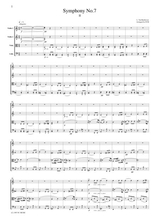
 10 Beethoven references in popular cultureĦ) Artur Schnabel’s recording occupies the complete Beethoven piano sonatas top spot.
10 Beethoven references in popular cultureĦ) Artur Schnabel’s recording occupies the complete Beethoven piano sonatas top spot. 
We named the Royal Concergebouw Orchestra one of the best orchestras in the world.ĥ) Another great recording is Alfred Brendel with Vienna Philharmonic under Simon Rattle(Warner).
Five of the best lesser-known Beethoven works to discoverĤ) For the best recordings of Beethoven’s piano concertos, plump for Murray Perahia and the Concertgebouw/Haitink (Sony). 10 of the best arrangements of Beethoven’s musicģ) Carlos Kleiber and the Vienna Philharmonic are untouchable in their recordings of Beethoven‘s Symphonies Nos 5 & 7 (DG). The best recordings of all Beethoven’s SymphoniesĢ) Otherwise, Nikolaus Harnoncourt and the Chamber Orchestra of Europe offer freshness in their interpretations of Beethoven’s symphonies (Warner). On the Friday night performance, he actually spoke against HB 2 from the stage.įor this show, his sound was enough-warm, welcoming, and inclusive.We named Berlin Philharmonic one of the best orchestras in the world. According to his Facebook page, the encore was dedicated to all members of the LBGT community “who currently do not feel safe or welcome in the state of North Carolina” as a result of HB2. For the encore, he offered a nicely witty and similarly copacetic version of the Gavotte from Bach’s third Partita. Unsurprisingly, he earned a raucous ovation after it was over.īut he wasn’t quite done. Even the gritty cadenzas and rustic dances kept that core. But in Bendix-Balgley’s hands, the piece simply floated. It spends large chunks of time near the top of the instrument’s range with lots of complicated intervals and exposed runs. The Beethoven violin concerto is not a simple piece. Bendix-Balgley is originally from Asheville and went on to become First Concertmaster of the Berlin Philharmonic at age thirty-two. It was a thrilling ride.Īfter intermission, Noah Bendix-Balgley strode onstage to play some actual Beethoven. It was dizzying, and I suspect it wouldn’t work so well if you couldn’t pick out the bits of Beethoven as they flew by. At times, it felt like Adams was using Beethoven as a Trojan Horse to sneak in Mahler, Berio, and Lutosławski, composers known for piling together simultaneous, contrasting themes. And strange arrays of woodwinds picked out oddly thrilling accompaniments. Walls of brass charged through dissonant chords. The quartet soloists slashed through virtuosic conflicting lines.Ĭhimes, piano, and almglocken clanged in background patterns. Different themes clashed through the orchestra. It's wonderfully weird, like listening to Beethoven’s complete works while on powerful hallucinogens. He takes bits and pieces from across Beethoven’s oeuvre-rhythms from the 7th symphony, melodies from the opus 16 string quartets, fragments of the Grosse Fuge, and entire passages of the opus 135 string quartet-and combines them with his own predilections to create something completely new. What comes across immediately in Absolute Jest, however, is just how much Adams loves Beethoven. Adams loosely took inspiration from Stravinsky’s Pulcinella, in which Stravinsky reconfigures music by Pergolesi to his own intellectual, detached ends. The concert began with the Adams, written for the highly unusual combination of string quartet and orchestra, with the quartet part played by the symphony’s principal players. 
This North Carolina Symphony concert at Memorial Hall in Chapel Hill was no different, with one piece by Beethoven-his 1806 violin concerto-and one literally built from Beethoven- John Adams’s 2012 Absolute Jest. Even when he’s not on the program, the institution is built on and around his veneration. Symphony: Beethoven's Violin ConcertoĮvery orchestra concert is, at some level, about Beethoven.







 0 kommentar(er)
0 kommentar(er)
